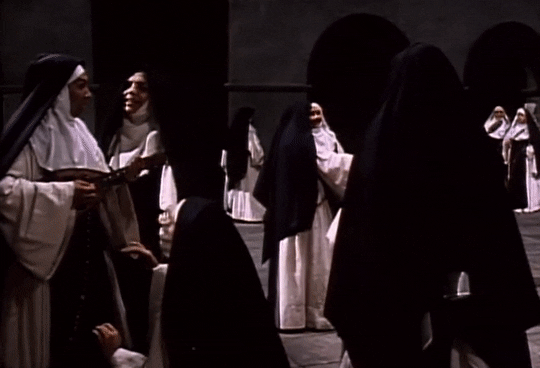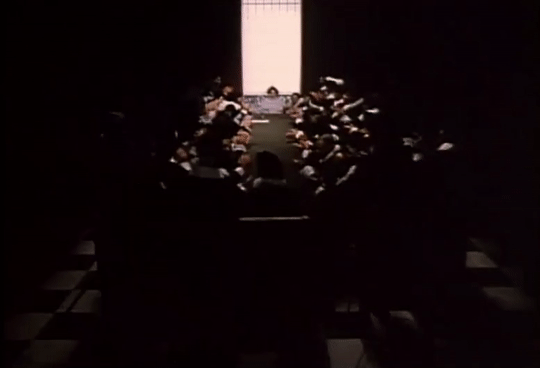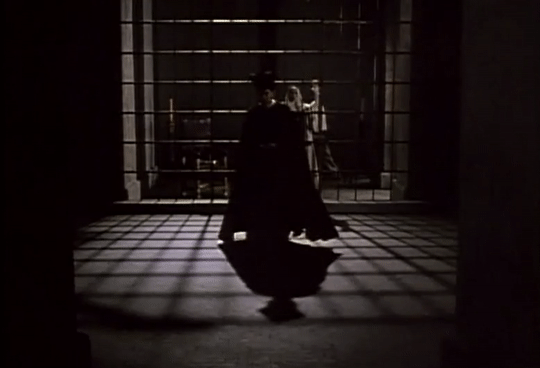#Sor María
Explore tagged Tumblr posts
Text
La sagrada relación con la vida en" Solo un poco aquí" de María Ospina. Por Ana Laura Santamaría
“Kati inclina el cuello, alza las orejas y afina el oído como siempre hace para descifrar los enigmas”, con esta descripción inicia El coloquio de las perras, relato con el que abre María Ospina su libro de relatos Solo un poco aquí, Premio Sor Juana Inés de la Cruz 2023, (premio destinado a reconocer la obra de escritoras de cualquier nacionalidad que publiquen en español). La descripción del…
0 notes
Text
Sobre la caída de Lucifer y sus ángeles apóstatas, por Sor María Jesús de Ágreda (1602-1665) en su obra, ‘Mística Ciudad de Dios���.

View On WordPress
#Apocalipsis 12#Últimos Tiempos#Caída de Lucifer#Mística Ciudad de Dios#Sor María Jesús de Ágreda#Teología
1 note
·
View note
Text

"Tomo cada momento por separado, ya que esto está en mi poder; el pasado no me pertenece, el futuro no es mío, el tiempo presente trato de aprovecharlo con todo el alma."
Sor María Faustina Kowalska.
Roberto Conte, 2015
1 note
·
View note
Text
twenty books in spanish, tbr
for when i'm fluent!! most with translations in english.
Sistema Nervoso, Lina Meruane (2021) - Latin American literature professor from Chile, contemporary litfic
Ansibles, perfiladores y otras máquinas de ingenio, Andrea Chapela (2020) - short story collection from a Mexican scifi author, likened to Black Mirror
Nuestra parte de noche, Mariana Enríquez (2019) - very long literary horror novel by incredibly famous Argentine journalist
Canto yo y la montaña baila, Irene Solà (2019) - translated into Spanish from Castilian by Concha Cardeñoso, contemporary litfic
Las malas, Camila Sosa Villada (2019) - very well rated memoir/autofiction from a trans Argentine author
Humo, Gabriela Alemán (2017) - short litfic set in Paraguay, by Ecuadoran author
La dimensión desconocida, Nona Fernández (2016) - really anything by this Chilean actress/writer; this one is a Pinochet-era historical fiction & v short
Distancia de rescate, Samanta Schweblin (2014) - super short litfic by an Argentinian author based in Germany, loved Fever Dream in English
La ridícula idea de no volver a verte, Rosa Montero (2013) - nonfiction; Spanish author discusses scientist Maria Skłodowska-Curie and through Curie, her own life
Lágrimas en la lluvia, Rosa Montero (2011) - sff trilogy by a Spanish journalist
Los peligros de fumar en la cama, Mariana Enríquez (2009) - short story collection, author noted above
Delirio, Laura Restrepo (2004) - most popular book (maybe) by an award-winning Colombian author; literary fiction
Todos los amores, Carmen Boullosa (1998) - poetry! very popular Mexican author, really open to anything on the backlist this is just inexpensive used online
Olvidado rey Gudú, Ana María Matute (1997) - cult classic, medieval fantasy-ish, award-winning Spanish author
Como agua para chocolate, Laura Esquivel (1989) - v famous novel by v famous Mexican author
Ekomo, María Nsué Angüe (1985) - super short litfic about woman's family, post-colonial Equatoguinean novel; out of print
La casa de los espíritus, Isabelle Allende (1982) - or really anything by her, Chilean author known for magical realism; read in English & didn't particularly love but would be willing to give it another try
Nada, Carmen Laforet (1945) - Spanish author who wrote after the Spanish civil war, v famous novel
Los pazos de Ulloa, Emilia Pardo Bazán (1886) - book one in a family drama literary fiction duology by a famous Galician author, pretty dense compared to the above
La Respuesta, Sor Juana Inés de la Cruz (1691) - i actually have a bilingual poetry collection from our favorite 17th century feminist Mexican nun; this is an essay defending the right of women to be engaged in intellectual work (& it includes some poems)
bookmarked websites:
Separata Árabe, linked by Arablit
reading challenge Un viaje por la literatura en español
#spanish langblr#spanish notes#can you imagine that if i grind i can start reading these this time next year?!?!?#3#nowtoboldlygo posts
161 notes
·
View notes
Text

La Madre Superiora se despierta y piensa:
- ¡Qué noche más hermosa he pasado!
Hoy no voy a maltratar a las pobres monjitas, más bien las voy a tratar bien.
Se levanta y comienza a recorrer las celdas:
- Buen día Sor Josefa, la veo muy bien esta mañana y también el jersey que está tejiendo
- "Gracias, Madre, usted también se ve muy bien, pero parece que se ha bajado por el lado equivocado de la cama".
No le gustó ni un poquito el comentario final, pero sin embargo continuó en la siguiente celda y repitió:
- Buen día Sor María, qué bien se le ve hoy, y qué bonito está quedando ese bordado.
- "Gracias, Madre usted también se ve bien, pero parece que se ha bajado por el lado equivocado de la cama".
La Superiora se mordió los labios, pero siguió su recorrido. Todas las monjitas le respondían lo mismo.
Así que cuando llegó a la quinta monja ya estaba enfurecida y la saludó con los dientes apretados:
- Buen día Sor Leonor, séame sincera... ¿Me veo como si me hubiera bajado por el lado equivocado de la cama?
- "Si, Madre..."
- ¿Y qué le hace pensar eso?
- "¡Es que lleva puestas las sandalias del padre Emilio!".
15 notes
·
View notes
Text

Marisa Paredes
Spanish star of films by Pedro Almodóvar, Guillermo del Toro and Roberto Benigni, and a champion of leftwing causes
The actor Marisa Paredes, who has died suddenly aged 78, was renowned for her elegance and “calm grace, that gentle cheerfulness that she ignited with one look of her pale eyes”, in the words of Gilles Jacob, former president of the Cannes film festival. She is best known for her roles in six films directed by Pedro Almodóvar.
After seeing her in a play, Almodóvar cast her as Sor Estiércol (Sister Manure) in Entre Tinieblas (Dark Habits, 1983). Later, she starred in his surreal melodrama Tacones Lejanos (High Heels, 1991). For her performance as a writer of romantic novels in his slightly more sober La Flor de Mi Secreto (The Flower of My Secret, 1995), she was nominated for a Goya best actress award. She also featured in Almodóvar’s Oscar-winning Todo Sobre Mi Madre (All About My Mother, 1999).
She became one of Spanish cinema’s great figures, but was also outspoken throughout her life in support of leftwing causes. As president of Spain’s film academy from 2000 to 2003, she attacked the participation of José María Aznar’s Conservative government in the planned invasion of Iraq. Her televised speech at the annual Goya awards in 2003 helped mobilise mass demonstrations: “There is no need to be afraid of culture, entertainment or freedom of expression, and much less satire or humour. We should be afraid of ignorance and dogmatism. We should be afraid of war.”
In the 1980s Paredes built a solid reputation in Spanish cinema, working with up-and-coming young directors, such as Fernando Trueba in Ópera Prima (Debut, 1980), Jaime Chávarri, Jaime Rosales and Agustí Vilaronga in Tras el Cristal (In a Glass Cage, 1986). Her performance in Vilaronga’s macabre anti-Nazi film was her own favourite. For José Sacristán’s comedy Cara de Acelga (Like Death Warmed Up, 1987) she was nominated for a Goya as best supporting actress.
In the 90s, her leading parts in Almodóvar films broadened her career into international cinema. She worked with Alain Tanner in France, Manoel de Oliveira in Portugal and shot two films with the Mexican Arturo Ripstein: Pintura Carmesí (Deep Crimson, 1996) and El Coronel No Tiene Quien le Escriba (No One Writes to the Colonel, 1999), a successful adaptation of a Gabriel García Márquez novel. She was in the Italian Roberto Benigni’s La Vita è Bella (Life Is Beautiful, 1997) and Guillermo del Toro’s El Espinazo del Diablo (The Devil’s Backbone, 2001). Over her six-decade career, she acted in more than 70 films.
The youngest of four daughters, Marisa was born in Madrid, in the block of flats on Plaza de Santa Ana where her mother, Petra (nee Bartolomé), was the concierge. Her father, Lucio Paredes, worked in the El Águila beer factory. These were years of hunger after the civil war (1936-39) and her family was poor. From the age of six, she told her mother she wanted to be an actor: the Teatro Español, one of the city’s main theatres, just across the square from her home, inspired her. Reasonably, her parents opposed this insecure career: they aspired for her to become a secretary. Paredes was always proud of her working-class origins. “My elegance comes from my grandfather, who was a farm-worker,” she would say.
Focused on her ambition, she left school aged 11, defeated parental opposition to study at the Madrid dramatic arts school and pushed her way into small film roles at the age of 14. In 1962 she met Fernando Fernán-Gómez, anarchist and brilliant actor and director, who helped mould both her acting and her view of the world. She acted in his film El Mundo Sigue (The World Continues, 1965).
In the 60s and 70s she worked in many films without breaking through to leading roles. The story was different on Televisión Española, where she acted in around 80 plays, often dramatisations of novels. “I had the good fortune that, as I don’t look Spanish ... when television was cultured and broadcast plays, I was in all the dramas of Chekhov, Dostoevsky, Ibsen. I was the Russian soul,” Paredes explained. She was an all-round talent, acting not just in theatre and highbrow TV, but in musicals, comedies and even a spaghetti western.
With her height, aristocratic bearing and blond hair, Paredes was reminiscent of a classic Hollywood star. Yet she was not vain: she had a warm smile and generous nature, and had the enthralling gift of great screen actors of expressing emotion with a single look or grimace.
She won prizes for her theatre, television and film work, and an honorary Goya for her career in 2018.
Paredes supported #MeToo vigorously and campaigned in the July 2023 general election for Sumar, the junior leftwing partner in Spain’s coalition government. As recently as 30 November, she read the manifesto in a demonstration against Israel’s actions in Gaza. She understood her political commitment in no narrow terms: “Freedom, education and culture are fundamental to human life. This is what remains. Art is what remains.”
Paredes had a daughter, María, with the film director Antonio Isasi-Isasmendi in 1975. From 1980 until her death she lived with José María Prado, director for 27 years of the Filmoteca Española (Spain’s film institute). She did not believe in marriage.
Prado and María survive her.
🔔 Marisa (María Luisa) Paredes Bartolomé, actor, born 3 April 1946; died 17 December 2024
14 notes
·
View notes
Text
Watch More Movies Notebook: September ‘24
(and a few things from August because I didn’t have the time to update last month!)

This month's blog journal features two contenders for best new-to-me films of the year (from Argentina and Brazil respectively), a handful of Depression-era shorts that range from absurdist comedy to Jungian fable to psychological actuality, plus one for the Sad Clown Hall of Fame (I've decided that's a real thing). Also included: a round up of recent posts and a preview of what's coming up this month.
Favorite New-to-me Films of the Month
(listed in order pictured above, L to R)
As always, if any other films catch your eye, but you need specific content/trigger warnings, feel free to ask and I’ll try to oblige!
READ on BELOW the JUMP!
I, the Worst of All / Yo, la peor de todas (1990)
[letterboxd | imdb | kanopy (US)]
María Luisa Bemberg’s film adaptation of Octavio Paz’s study of the life and work of Sor Juana Inés de la Cruz. Sor Juana was a 17th century polymath from (what is now) Mexico and the film recounts her struggles to continue her work and her relationship with the vicereine of New Spain.
This is easily one of my favorite new-to-me movies of the year so far. Biopics often feel formally stodgy to me, but Bemberg’s film is highly visual and plays with time, space, and symbolism, revealing emotional truths in ways that avoid going artificially melodramatic. The relationship between Sor Juana and the vicereine unfolds beautifully and both actresses, Assumpta Serna and Dominique Sanda, are fantastic. I would recommend checking this one out even if you haven’t read any of Sor Juana’s work—in fact, watching this movie will likely motivate you to get reading!
——— ——— ———
La cartomancienne (1932)
[letterboxd | imdb]
An experimental short about a lovelorn young woman seeking advice from a fortune teller. Jerome Hill’s first directorial outing is a Jungian fable peppered with references to supernatural folk beliefs. It’s evocatively constructed and has a great rhythm to it (paired with Hill’s original score). It’s a real gem!
——— ——— ———
Little Geezer (1932)
[letterboxd | imdb]
Theodore Huff took a mess of New Jersey ragamuffins, dressed them up as grown ups, had them act out half-remembered scenes from pre-code crime movies, and gave us the gift of Little Geezer. I found it genuinely funny, but, even if you don’t vibe with Huff’s sense of humour, you might get a kick out of how clearly the kids enjoyed playing gangsters or the shocking novelty of the kids smoking, drinking, carrying tommy guns, etc. Greta Garbage’s impression of Garbo was surprisingly great though??? Might not recommend this one as freely as the two above as Huff so densely packed Geezer with references you may need to have seen all of the movies referenced to pick up what Huff is putting down.
——— ——— ———
The City (1939)
[letterboxd | imdb]
A short, five-part documentary about American city planning produced for the New York World’s Fair of 1939 might be a hard sell for some, but with its truly outstanding creative team, The City is more compelling viewing than you might assume! The City was conceived by housing advocate Catherine Bauer, written by documentarian Pare Lorentz (The Plow that Broke the Plains) and Lewis Mumford, directed by Ralph Steiner (H2O, Mechanical Principles, Surf and Seaweed) and future MoMA director Willard Van Dyke (Hands), assisted by Henwar Rodakiewicz (Portrait of a Young Man in Three Movements), and scored by Aaron Copland. I might have some personal bias here as I grew up in NJ and have lived in New York and Pittsburgh, but as a modern viewer, I found The City to be an interesting window into the past.
——— ——— ———
White Paradise / Bílý ráj (1924)
[letterboxd | imdb | Watch at Národní filmový archiv]
Looks like Christmas X Criminals also has a tradition outside of the English-speaking world! Anny Ondra plays Nina, a whimsical young orphan under the guardianship of a nasty tavern keeper. On Christmas Eve, Ivan, a man framed for a crime against Nina’s parents, escapes prison to spend one last holiday with his ailing mother. Together, Ivan and Nina with the aid of a travelling puppeteer uncover the true bandit, exonerating Ivan and freeing Nina.
Bílý ráj is a charming film shot on location in the Šumava forest in Bohemia. Don’t be put off by the overly literal English translation of the title, the connotations are off by modern standards! This will be a solid recommendation for the coming winter months and I’m thinking about putting together a little list of some of the best Christmas X Criminals movies out there. If you have any underappreciated/underseen instances of the trope please suggest them to me! Bonus: it has a wonderful poster!

——— ——— ———
Seeing the World, Part One: A Visit to New York, N.Y. (1937)
[letterboxd | imdb]
This cheeky short by Rudy Burckhardt is a mock travelogue about visiting New York City. Referencing both Traveltalks shorts and the city symphony films, Burckhardt playfully jumbles genres and the film’s acerbity doesn’t overstay its welcome with a ~10 minute runtime. Also, Seeing the World features Joseph Cotten’s first screen role!
——— ——— ———
The Golden Clown / Klovnen (1926)
[letterboxd | imdb]
The great Gösta Ekman turns in one of the best silent film performances I’ve ever seen in this. Ekman plays Joe Higgins, a talented young clown in a travelling circus. Joe is in love with Daisy, the stunt rider and daughter of the circus’ owners. A twist of fate results in Joe becoming a top performer, headlining his own theatrical production in Paris. Unfortunately, Joe becomes a workaholic and Daisy gets romanced on the side by a caddish fashion designer. Both of their lives fall apart after they decide to divorce. A.W. Sandberg does a phenomenal job of heightening personal tragedy to an epic scale. I was astounded at how smoothly Ekman performed twenty years worth of aging in two hours. As much as I enjoyed this film (and cried over the finale), it did leave me wondering if they make movies about happy clowns? CW/TW for suicide.
——— ——— ———
April Fool (1924)
[letterboxd | imdb]
An occasional habit of mine is to watch silent comedy shorts during my lunch break. One afternoon this month, I watched three Charley Chase/Jimmy Jump shorts. They were all winners, but April Fool was my favorite. On the first of April, Jimmy Jump gets blindsided by pranks when he arrives at work. Jimmy swears he won’t get pranked again and makes a bet with his coworker (Noah Young). Chaos ensues. The other shorts I watched, Publicity Pays (1924) and A Ten-Minute Egg (1924), were also good, though not as tightly constructed. Publicity Pays features an especially sweet and well-behaved monkey BTW.
——— ——— ———
Footnote to Fact (1933)
[letterboxd | imdb]
A harrowing short by Lewis Jacobs documenting The Great Depression in New York City. Originally intended to be part of a series that wasn’t completed, Footnote to Fact survived on its own (thanks to Anthology Film Archives) as a stream-of-consciousness rhythmic portrait of the quotidian horror of the Depression. Honestly, I can’t believe I hadn’t seen this earlier, but I’m glad to have finally remedied that. Worth checking out, if you’re in a place to handle it. TW/CW for suicide and depictions of real dead animals (in a butcher window).
——— ——— ———
The Hole in the Wall (1929)
[letterboxd | imdb]
After a major train accident, The Fox (Edward G. Robinson) and his crew are forced to rework their phony psychic scheme. When Jean (Claudette Colbert) knocks on their door, fresh off a prison sentence for a crime she didn’t commit, she takes on the role of their faux medium. Jean has her own revenge plot in mind: kidnapping the granddaughter of the rich woman who framed her.
I came across this movie when reading about Robert Florey’s feature films and I’m glad I did—as a big fan of both Robinson and Colbert. Robinson doesn’t have all that much to do in the movie, but he’s very charming in it. Colbert gets the most to do with the conflicted Jean—a woman who chooses a life of crime only after a life of crime was chosen for her. But, the real reason this overlooked pre-code made this list is that the climax of the film was such a shock to me! I won’t give it away in case you decide to check it out yourself, but I never anticipated that!
——— ——— ———
Quilombo (1984)
[letterboxd | imdb | kanopy (US)]
I’ve had really great luck working through my watchlist lately. Yo, la peor de todas is certainly on my best new-to-me list for the whole year and so is Quilombo! Quilombo is a fantasticized telling of the true story of Palmares, a free community of escaped slaves in colonial-era Brazil. The film primarily focuses on the events surrounding the fight to remain free of Portuguese authorities while Ganga Zumba and later Zumbi led the settlement. As I’m not Brazilian, this history was largely new to me and it’s been enriching to learn more about it. To me, this film seems like a great entry point. It’s stylish in a meaningful way, has a fantastic soundtrack (which I’ve already listened to twice since watching the film), and the production design, editing, and performances are all super. Also, Quilombo is a film worth studying if you want to see how a filmmaker can artistically condense a large span of time to fit feature length without awkwardly hopping along a timeline of events like a slideshow brought to life.
——— ——— ———
Monthly Round-up
In case you missed it, I spent the better part of the last few months constructing and heavily researching “Cosplay the Classics: Nazimova in Salomé.” There were so many compelling avenues to go down that I split the cosplay into two and a half parts!

Part One: “The Importance of Being Peter” covers Nazimova’s creative decisions in adapting Oscar Wilde’s play for the silent screen—illustrating both her filmmaking techniques and her keen awareness of her core fanbase: young/independent women.

Part Two: “Artists United?” details the struggles Nazimova had in getting Salomé released and finding its audience. This part describes how the American film industry was growing and changing in the early 1920s and how Nazimova’s independent productions fit into (or didn’t fit into) that landscape. I also aimed to complicate the oversimplified narrative of Salomé as a flop by collecting and analysing data surrounding its release in comparison to her Metro films.
Part Two Point Five (a.k.a. Cosplay the Classics: Post-script) will be up soon. It’s a slightly shorter piece covering Salomé’s place in cinematic Orientalism. Stay tuned!
——— ——— ———
Since the last notebook installment, I made themed gif/still sets for:
The Golden Clown (1926)

Salvation Hunters (1925)
(which I talked about in the last installment of WMM Notebook)

Danse Macabre (1922)

Yo, la peor de todas (1990)

A Day in Santa Fe (1931)
(which I talked about in the last installment of WMM Notebook)

I also made some gifs of my Salomé cosplay, because I was so pleased with how the wig turned out I needed to show it in motion!

——— ——— ———
In addition to the follow-up to “CtC: Salomé,” I’m working on a quick how-to rundown of the cosplay, in case you need some Halloween inspiration!
I’ve also got a slate of spooky-season appropriate gifs/stills to post here on tumblr for October.
Until next time, Happy Halloween and Happy viewing!
——— ——— ———
☕Appreciate my work? Buy me a coffee! ☕
#film#movie review#film recommendation#movie recommendations#month in review#roundup#classic film#classic movies#silent movies#silent film#silent cinema#cinema#film blog#1920s#1930s#1980s#1990s#silent comedy#american film#brazilian film#czechoslovak cinema#argentinian film#danish film#experimental film#avant garde film#avant garde cinema#art film#documentary
8 notes
·
View notes
Photo










YO, LA PEOR DE TODAS (1990) dir. María Luisa Bemberg An examination on the life of Sor Juana Inés de la Cruz, a Roman Catholic nun from Mexico City who, in the midst of the Spanish Inquisition, established herself as an important New World philosopher, poet, playwright and early feminist. When Sor Juana comes under the scrutiny of a vicious archbishop for her unconventional ways, she must appeal to a powerful political connection - the Viceroy's scholarly wife. (link in title)
#lgbt cinema#lesbian cinema#yo la peor de todas#i the worst of all#argentinian cinema#lgbt#argentina#lesbian#bisexual#lgbt movie#lesbian movies#argentinian movies#lgbt film#lesbian film#argentinian film#lgbt media#lesbian media#queer cinema#latin american cinema#latin cinema#maría luisa bemberg#assumpta serna#dominique sanda#1990#90s#1990s#90s movies#90s cinema#90s films#1990s movies
104 notes
·
View notes
Text

José de Alcíbar, Votive Portrait of Sor. M. María Anna Josefa de San Ignacio, 1793 x
5 notes
·
View notes
Text

Sor María de Jesús why would you write that. Why would you tell your good buddy Felipe that God hates the way all his wives and daughters and nieces dress. Sor María you and I both know that is a very rude thing to do to an old man with depression.
#felipe iv#philip iv of spain#habsburgs#serious scholarly historical pursuits#(the book is incomparable realms by jeremy robbins)
14 notes
·
View notes
Text



Reading List - Lista para Leer
Aves sin nido Clorinda Matto de Turner
Dom Casmurro Joaquim Maria Machado de Assis
Ariel José Enrique Rodó
El Moto Joaquin Garcia Monge
La amada inmóvil Amado Nervo
Desolación Gabriela Mistral
La señorita Etcétera Arqueles Vela
La vorágine José Eustasio Rivera
Doña Bárbara Rómulo Gallegos
Cuentos de Amor, de Locura y de Muerte Horacio Quiroga
Other selected works
Isabel Allende, “Dos palabras”
Anónimo, “Romance de la pérdida de Alhama”
Anónimo, Lazarillo de Tormes (Prólogo; Tratados 1, 2, 3, 7)
Gustavo Adolfo Bécquer, Rima LIII (“Volverán las oscuras golondrinas”)
Jorge Luis Borges, “Borges y yo”
Jorge Luis Borges, “El Sur”
Julia de Burgos, “A Julia de Burgos”
Miguel de Cervantes, Don Quijote (Primera parte, capítulos 1–5, 8 y 9; Segunda parte, capítulo 74)
Julio Cortázar, “La noche boca arriba”
Hernán Cortés, “Segunda carta de relación” (selecciones)
Sor Juana Inés de la Cruz, “Hombres necios que acusáis”
Rubén Darío, “A Roosevelt”
Don Juan Manuel, Conde Lucanor, Exemplo XXXV (“De lo que aconteció a un mozo que casó con una mujer muy fuerte y muy brava”)
Osvaldo Dragún, El hombre que se convirtió en perro
Carlos Fuentes, “Chac Mool”
Federico García Lorca, La casa de Bernarda Alba
Federico García Lorca, “Prendimiento de Antoñito el Camborio en el camino de Sevilla”
Gabriel García Márquez, “El ahogado más hermoso del mundo”
Gabriel García Márquez, “La siesta del martes”
Garcilaso de la Vega, Soneto XXIII (“En tanto que de rosa y azucena”)
Luis de Góngora, Soneto CLXVI (“Mientras por competir con tu cabello”)
Nicolás Guillén, “Balada de los dos abuelos”
José María Heredia, “En una tempestad”
Miguel León-Portilla, Visión de los vencidos (dos secciones: “Los presagios, según los informantes de Sahagún” y “Se ha perdido el pueblo mexica”)
Antonio Machado, “He andado muchos caminos”
José Martí, “Nuestra América”
Rosa Montero, “Como la vida misma”
Nancy Morejón, “Mujer negra”
Pablo Neruda, “Walking around”
Emilia Pardo Bazán, “Las medias rojas”
Francisco de Quevedo, Salmo XVII (“Miré los muros de la patria mía”)
Horacio Quiroga, “El hijo”
Tomás Rivera, . . . y no se lo tragó la tierra (dos capítulos: “... y no se lo tragó la tierra” y “La noche buena”)
Juan Rulfo, “No oyes ladrar los perros”
Alfonsina Storni, “Peso ancestral”
Tirso de Molina, El burlador de Sevilla y convidado de piedra
Sabine Ulibarrí, “Mi caballo mago”
Miguel de Unamuno, San Manuel Bueno, mártir

#lista para leer#catholic#feminine#reading list#Spanish reading list#spanish#reading#books to read#classic books
7 notes
·
View notes
Text
Maruja Mallo & Rosalía de Castro

Meditación en el umbral No, no es la solución tirarse bajo un tren como la Ana de Tolstoy ni apurar el arsénico de Madame Bovary ni aguardar en los páramos de Ávila la visita del ángel con venablo antes de liarse el manto a la cabeza y comenzar a actuar. Ni concluir las leyes geométricas, contando las vigas de la celda de castigo como lo hizo Sor Juana. No es la solución escribir, mientras llegan las visitas, en la sala de estar de la familia Austen ni encerrarse en el ático de alguna residencia de la Nueva Inglaterra y soñar, con la Biblia de los Dickinson, debajo de una almohada de soltera. Debe haber otro modo que no se llame Safo ni Mesalina ni María Egipciaca ni Magdalena ni Clemencia Isaura. Otro modo de ser humano y libre. Otro modo de ser.
- Rosalía de Castro
7 notes
·
View notes
Text
Today is my mom's day for two reasons: the Blessed Virgin and the nun that was my novice mistress is called Sor María Pilar and today is her birthday.
3 notes
·
View notes
Text

@mythvoiced sent in: "if you knew tomorrow was your last day, how would you spend it?" - María @ victor Patrick ofc, I'm so sor-- || time for a heart-to-heart ( prompts for deep conversations. )
How many times has he thought about it: his last day. How would it go? What would he do? He used to think about those twenty four hours a lot back then. Back then when he wasn’t just waiting for that ‘last day’, no he planned for it. Multiple times, multiple ‘last days’. He picked those days on the calendar and made an itinerary for how twenty four hours would be spent. If Snow owned his body in life, then those twenty four hours along with his death would be Patrick’s and Patrick’s alone.
At least that was how his younger self thought. Nowadays, he no longer runs towards those twenty four hours, so much as waits for them to appear at his doorstep.
It can’t be that much different for the other victors; he’s never asked simply because it’s always been apparent amongst them all: no one ever truly left the arena. It’s a one-way passage with no u-turns and the only escape involves leaving behind one’s own corpse.
The newest victor is only beginning to realize that now. And despite her empty words and threats, and promises of a better world, he almost wishes that she didn’t. Maybe it is foolish of him, but…cynicism doesn’t suit her. And for all the times it has gotten her in trouble, her naivety is what makes her, well, preferable to be around in comparison to some of the other victors.
( He’s always been drawn to the TROUBLEMAKERS anyways. )
But even the most dogged of souls will have their moments of doubt. And if she’s supposed to be having hers, then what more can he do aside from guide her through it? Whether it breaks her or strengthens her resolve is for her to decide.
In Patrick’s case, the decision boiled down to not a purpose, but rather a reason. A series of tiny reasons to keep going. If there is no grand scheme that any of this will result in, then he will create a series of smaller ones. Smaller, mundane reason that perhaps, will not truly matter in the end, but would, in his eyes, mean no less.
That’s how he SURVIVED.

Maybe that’s how she will too.
“...Find Sun-ah and spend the day with her.” Sun-ah, his cat of many years- not that María would know. Now a grimalkin, Sun no longer could make the trip to the Capitol ( not that he would have let her anyways ) so he would go home to her instead. “Why do you ask, hm?”
#suicidal ideation cw#suicide cw#mythvoiced#mythvoiced ( maría. )#anger said her real name was grief ( maría. )#the victor ( verse three. )#the victor ( answered. )#it is time for us all collectively to suffer and mourn and suffer some more in this verse#literally this verse makes the black knight verse seem so bright.....:/#but LEN THANK YOU FOR this!!#i knew immediately how i was going to answer this once i got it :'D#the way i ADORE MARÍA DESPITE ALL THE CHAOS AND PANIC SHE GIVES PATRICK#it's good for him...gets his blood pumping#makes him actually feel more alive </3
4 notes
·
View notes
Text
The Bélmez Faces And Other Andalusian Ghost Stories
This week, Aly brings you three short ghost stories from the Andalusian region of Spain.
From Sevilla comes the story of Sor Úrsula, the twisted nun who lives in the Andalusian parliament building. Known for dragging souls to Hell, many politicians have claimed to see her walking the halls and a security guard is even said to have died after he had the misfortune of running into her late at night.
From Málaga we hear the tale of the ghostly black carriage whose mysterious occupant abducts strangers late at night. If the stranger does not present an offering of a child's blood, the man in the carriage rips the strangers away to be turned into elixirs and salves.
Finally, from the province of Jaén comes the infamous story of the Bélmez Faces. When María discovers a ghostly face forming in the concrete floor of her kitchen, her husband destroys it with an axe. Thinking their troubles are over, they are alarmed to find more faces rapidly forming throughout the house in the ensuing days. When headless skeletons are discovered beneath the house's foundation, speculation throughout Spain runs wild. Is Marías house built over a portal to Hell? Is María capable of telekinesis? Or is it all just an elaborate hoax? Tune in now to find out!
#The Bélmez Faces And Other Andalusian Ghost Stories#Sor Úrsula#Let's Get Haunted#Andalusian parliament building#drag souls to hell#Spotify
2 notes
·
View notes
Text
Las Hermanas de la Cruz lamentan la "sangrante paradoja" de que cada vez haya más pobres en una España "cada vez más rica"

Las Hermanas de la Cruz lamentan la "sangrante paradoja" de que cada vez haya más pobres en una España "cada vez más rica"
La superiora de la Casa de Roma, María del Redentor de la Cruz, protagoniza una histórica y emotiva ponencia en la Catedral de Sevilla en la que pone múltiples "rostros" a la pobreza y atribuye a las hermandades un papel crucial en "la reconstrucción de los valores morales"
Las Hermanas de la Cruz, las "mendigas verdaderas" que dedican su alma y su vida a cuidar y "amar hasta los extremos" a los pobres desde la más absoluta humildad y modestia, han cumplido este sábado con un hito sin precedentes en su historia: hablar en público. Lo han hecho en el escenario más magnífico posible, la Catedral de Sevilla, pero la grandiosidad no ha estado en el marco sino en el mensaje que, con voz quebrada por la emoción, por la pureza de sus palabras y por la herencia recibida de Santa Ángela, ha leído María del Redentor de la Cruz, superiora de la Casa de Roma. Además de enumerar todos los "rostros" de la pobreza, desde los inmigrantes a las "víctimas de la prostitución y las drogas", también ha lamentado la "sangrante paradoja" de estos tiempos que les ha tocado vivir en los que "mientras el país es cada vez más rico, aumenta el número de pobres".
Una hora ha durado la ponencia de quien ha oficiado de portavoz de una orden tan respetada que la atención ha sido máxima por parte del millar de asistentes, tan aplaudida que no se recuerda una ovación más larga en lo que va de Congreso de Hermandades y Piedad Popular y tan modesta que la monja ha escuchado las palmas casi sin querer mirar al público, quizás abrumada por el honor y casi seguro que pensando que no las merecía. Poco antes, por ejemplo, había recordado "cómo emociona" el agradecimiento que les expresan las 150 familias a las que atienden, cada una "según su cultura", y cómo algunas de esas personas "llegan a arrodillarse e intentan besarnos los pies". "Esto nos avergüenza tanto...", ha confesado. A unos metros asentía interiormente la otra representante de la orden en este acto histórico, la vicaria de la Institución María del Robledo.
Porque las Hermanas de la Cruz no viven por ellas mismas sino por el prójimo más vulnerable, aquel que tiene muy poco o nada. "Cuando tocamos a los pobres, estamos tocando la carne de Cristo", ha resumido en un momento de su aloución, en la que ha pedido colaboración con la Obra Social Centro de Noche, que presta atención a personas sin hogar. "No podemos dar la espalda a la amarga realidad de la pobreza", ha reivindicado antes de señalar los "rostros" de esa lacra: "Familias que abandonan su tierra para buscar su subsistencia en otros lugares, huérfanos, ancianos olvidados por sus familias que ahora se han convertido en alivio económico para muchas de ellas, víctimas de prostitución o drogas, los inmigrantes víctimas de tantos intereses ocultos, las personas que vemos en los vertederos buscando algo para comer o vestirse...", ha enumerado.
Sor María del Redentor de la Cruz ha lamentado entonces esa "sangrante paradoja" de una España "cada vez más rica" en la que sin embargo también hay cada vez más pobres. Y como ejemplo insuperable, Sevilla: "El Polígono Sur y Los Pajaritos aparecen como los barrios más pobres de España. Sevilla es la ciudad con más barrios pobres de España", ha recordado.
La pobreza por la que viven las sucesoras de Santa Ángela no sólo es material, también es "espiritual". "Azotan nuestro tiempo la indiferencia religiosa, el olvido de Dios, la ligereza con que se cuestiona su existencia", ha recalcado la ponente.
Frente a esa vida aparentemente perdida, Sor María ha destacado "cómo Dios entra en las vidas" de los desfavorecidos y estos "se transforman en hombres nuevos". Y no se ha quedado en la teoría ni en los conceptos abstractos, sino que ha ido al día a día, al nombre propio, a la historia de Pipo, un usuario que "vivía en una casa llena de suciedad y renegaba de Dios" antes de que las Hermanas contactasen con él. "Bastó el simple gesto de arrodillarnos para lavarle los pies para que renaciera en la esperanza. En pocos días era un hombre rendido a Dios, como un bebé en los brazos de su madre", ha contado. O Elvia, una mujer enferma de cáncer con tres hijos pequeños que cuando recibió el "cariño" de las monjas "abrió su corazón" y les reveló que había renunciado a la fe tras entrar en una secta. "Las hermanas la llenaron de esperanza y en su lecho de muerte hizo profesión de fe y vio cómo sus hijos se bautizaban. Murió en paz, volviendo a ser hija de la Iglesia", ha narrado.
Y toda esa labor de resucitar no a los muertos, sino a los vivos, es afrontada por las "hijas" de Santa Ángela desde algo más que el anonimato o el altruismo. "Debemos estar tan escondidas y oscurecidas que nadie se preocupe de nosotras. Debemos ir a la última planta de un bloque de vecinos, donde hay una tísica que moriría desamparada si no fuera por las hermanas, y le damos alimentos, le curamos las llagas y hacemos cosas repugnantes sin que nos muevan ni el interés ni el cariño, porque no la conocíamos. Eso es trabajar debajo de la tierra", ha proclamado.
Esa labor, de otra manera, también es realizada por las hermandades de Sevilla. Sor María ha recordado que hace años aportaban un total de seis millones de euros en obras de caridad y se ha mostrado convencida de que esa cantidad hoy en día es "bastante mayor", aunque "se refiere sólo a lo cualificable". Es decir, que hay "muchas más manifestaciones" de esa caridad, como el trabajo con "presos, mujeres vulnerables, hogares de acogida, becas universitarias, mayores, sin techo, economatos...". "Las hermandades tienen en su mano en gran parte la reconstrucción de nuestros valores morales", ha concluido.
Que le pregunten a Alberto Díaz, el jefe de gabinete del alcalde Zoido, que localizó a la superiora de la orden para comunicarle la propuesta de nombrar hijas predilectas de Sevilla a las Hermanas de la Cruz. "Dígale al señor alcalde que no es necesario, no podemos aceptar honores. Ya sentimos cada día que los sevillanos nos quieren y reconocen. De verdad, dígale que estamos muy agradecidas, pero no es necesario".
0 notes